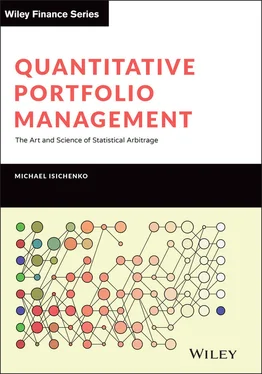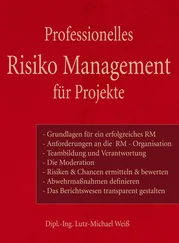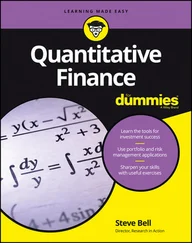Historically, statistical arbitrage started as trading pairs of similar stocks using mean-reversion-type alpha signals betting on the similarity. 4 The strategy appears to be first used for proprietary trading at Morgan Stanley in the 1980s. The names often mentioned among the statarb pioneers include Gerry Bamberger, Nunzio Tartaglia, David E. Shaw, Peter Muller, and Jim Simons. The early success of statistical arbitrage started in top secrecy. In a rare confession, Peter Muller, the head of the Process Driven Trading (PDT)group at Morgan Stanley in the 1990s, wrote: Unfortunately, the mere knowledge that it is possible to beat the market consistently may increase competition and make our type of trading more difficult. So why did I write this article? Well, one of the editors is a friend of mine and asked nicely. Plus, chances are you won't believe everything I'm telling you . 5 The pair trading approach soon developed into a more general portfolio trading using mean reversion, momentum, fundamentals, and any other types of forecast quants can possibly generate. The secrets proliferated, and multiple quantitative funds were started. Quantitative trading has been a growing and an increasingly competitive part of the financial landscape since early 1990s.
On many occasions within this book, it will be emphasized that it is difficult to build successful trading models and systems. Indeed, quants betting on their complex but often ephemeral models are not unlike behavioral speculators, albeit at a more technical level. John Maynard Keynesonce offered an opinion of a British economist on American finance: 6 Even outside the field of finance, Americans are apt to be unduly interested in discovering what average opinion believes average opinion to be; and this national weakness finds its nemesis in the stock market... It is usually agreed that casinos should, in the public interest, be inaccessible and expensive. And perhaps the same is true of stock exchanges .
_____________
1 4M. Avellaneda, J.-H. Lee. Statistical arbitrage in the US equities market, Quantitative Finance, 10(7), pp. 761–782, 2010.
2 5P. Muller, Proprietary trading: truth and fiction, Quantitative Finance, 1(1), 2001.
3 6J.M. Kaynes, The General Theory of Employment, Interest, and Money, Macmillan, 1936.
This book touches upon several theoretical and applied disciplines including statistical forecasting, machine learning, and optimization, each being a vast body of knowledge covered by many dedicated in-depth books and reviews. Financial forecasting, a poor man's time machine giving a glimpse of future asset prices, is based on big data research, statistical models, and machine learning. This activity is not pure math and is not specific to finance. There has been a stream of statistical ideas across applied fields, including statements that most research findings are false for most research designs and for most fields . 7 Perhaps quants keep up the tradition when modeling financial markets. Portfolio optimization is a more mathematical subject logically decoupled from forecasting, which has to do with extracting maximum utility from whatever forecasts are available.
Our coverage is limited to topics more relevant to the quant research process and based on the author's experience and interests. Out of several asset classes available to quants, this book focuses primarily on equities, but the general mathematical approach makes some of the material applicable to futures, options, and other asset classes. Although being a part of the broader field of quantitative finance, the topics of this book do not include financial derivatives and their valuation, which may appear to be main theme of quantitative finance, at least when judged by academic literature. 8 Most of the academic approaches to finance are based on the premise of efficient markets, 9 precluding profitable arbitrage. Acknowledging market efficiency as a pretty accurate, if pessimistic, zeroth-order approximation, our emphasis is on quantitative approaches to trading financial instruments for profit while controlling for risks. This activity constitutes statistical arbitrage.
When thinking about ways of profitable trading, the reader and the author would necessarily ask the more general question: what makes asset prices move, predictably or otherwise? Financial economics has long preached theories involving concepts such as fundamental information, noise and informed traders, supply and demand, adaptivity, 10 and, more recently, inelasticity, 11 which is a form of market impact (Sec. 5.4). In contrast to somewhat axiomatic economists' method, physicists, who got interested in finance, have used their field's bottom-up approach involving market microstructure and ample market data. 12 It is definitely supply and demand forces, and the details of market organization, that determine the price dynamics. The dynamics are complicated, in part due to being affected by how market participants learn/understand these dynamics and keep adjusting their trading strategies. From the standpoint of a portfolio manager, price changes are made of two parts: the impact of his own portfolio and the impact of others. If the former can be treated as trading costs, which are partially under the PM's control, the latter is subject to statistical or dynamical modeling and forecasting.
_____________
1 7J.P.A. Ioannidis, Why Most Published Research Findings Are False, PLoS Med 2(8): e124, 2005.
2 8P. Wilmott, Frequently Asked Questions in Quantitative Finance, Wiley, 2009.
3 9P.A. Samuelson, Proof That Properly Anticipated Prices Fluctuate Randomly, Industrial Management Review, 6, pp. 41–49, 1965.
4 10A.W. Lo, The Adaptive Markets Hypothesis: Market Efficiency from an Evolutionary Perspective, Journal of Portfolio Management, 30(5), pp. 15–29, 2004.
Among other things, this book gives a fair amount of attention to the combination of multiple financial forecasts, an important question not well covered in the literature. Forecast combination is a more advanced version of the well-discussed theme of investment diversification. Just like it is difficult to make forecasts in efficient markets, it is also difficult, but not impossible, to optimally combine forecasts due to their correlation and what is known as the curse of dimensionality. To break the never ending cycle of quantitative trial and error, it is important to understand fundamental limitations on what can and what can't be done.
The book is structured as follows. Chapter 1briefly reviews raw and derived market data used by quants. Alpha generation, the central part of the quant process, is discussed in Chapter 2. This chapter starts with additional financial data usable for forecasting future asset returns. Both theoretical and algorithmic aspects of machine learning (ML) are discussed with an emphasis on challenges specific to financial forecasting. Once multiple alphas have been generated, they need to be combined to form the best possible forecast for each asset. Good ways of combining alphas is an alpha in itself. ML approaches to forecast combining are discussed in Chapter 3. A formal view of risk management, as relevant to portfolio construction, is presented in Chapter 4. Trading costs, with an emphasis on their mathematical structure, are reviewed in Chapter 5. There a case is made for a linear impact model that, while approximate, has a strong advantage of making several closed-form multi-period optimization solutions possible. Impact of a net flow of funds at a macro scale is also discussed with implications for stock market elasticity and bubbles. Chapter 6describes the construction of a portfolio optimized for expected future profits subject to trading costs and risk preferences. This part tends to use the most math and includes previously unpublished results for multi-period portfolio optimization subject to impact and slippage costs. Related questions of portfolio capacity and optimal leverage, including the Kelly criterion, are also discussed. Chapter 7concerns the purpose and implementation of a trading simulator and its role in quant research. A few auxiliary algorithmic and mathematical details are presented in appendices.
Читать дальше












